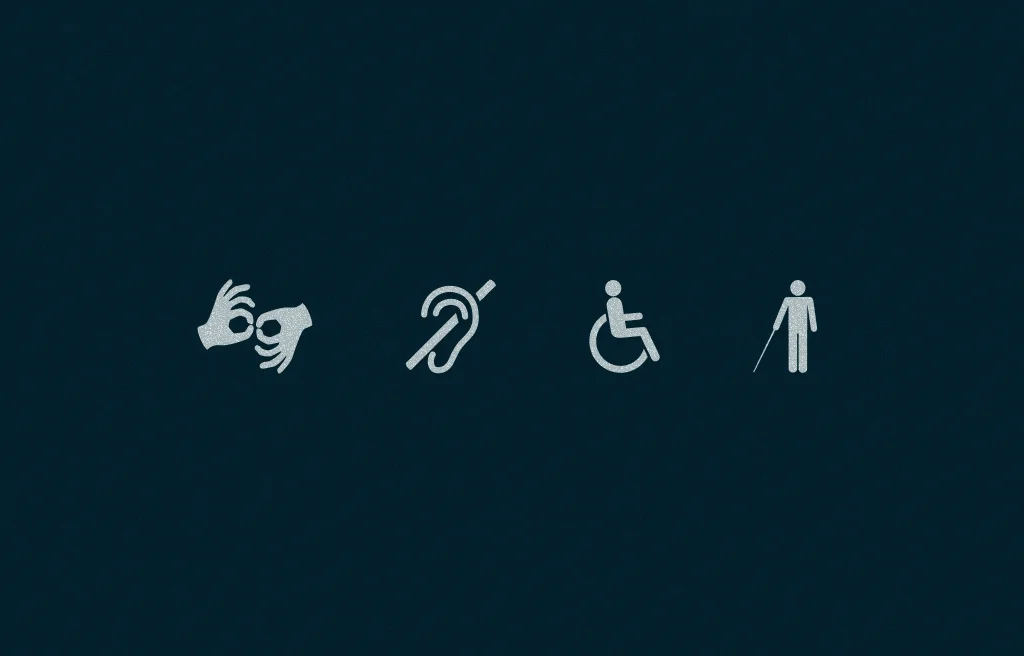Some time ago, I read a phrase that stuck in my head: “It’s not enough to not be ableist; you need to be anti-ableist.” This means recognizing that we live in an ableist country.
The phrase was uttered by the social scientist and member of the Disability and Accessibility Committee of the Brazilian Anthropology Association, Julian Simões, in an interview with Agência Brasil.
When I read Julian’s phrase, I questioned its content: “Why do I need to fight against ableism? Isn’t it enough if I’m not ableist already?”
Researching about it, I found the answers to my questions, and I realized that this has everything to do with Brazilian companies.

Ableism is ingrained in society (and probably in your company)
In case you don’t know:
- Ableism is a form of prejudice, discrimination against persons with disabilities (PWDs). The influencer Ivan Baron, who has cerebral palsy and has been advocating for inclusion on social media since 2018, explains in a video that ableism is a way of doubting the capacity, violating, and stereotyping PWDs.
- Anti-ableist is a term that refers to the fight against ableism.
According to a survey released in 2022 by the Brazilian Institute of Geography and Statistics (IBGE), there are 17.2 million PWDs in Brazil. This represents 8.4% of the population.
The Brazilian law No. 13,146/2015,, known as the Inclusion Law, is very clear in stating that:
Every person with a disability has the right to equal opportunities with other people and shall not suffer any kind of discrimination.”
This law guarantees various rights for PWDs regarding health, work, education, transportation, among others.
Article 93 of Law No. 8,213/91, known as the Disability Quotas Law, states that “The company with 100 (one hundred) or more employees is obliged to fill from 2% (two percent) to 5% (five percent) of its positions with rehabilitated beneficiaries or people with disabilities.”
Now, think with me: millions of people with disabilities live in our country. There are various rules related to this audience. But still, a large part of the companies does not make it a premise to create accessible content and experiences.
My question here is: why?
Social scientist Julian Simões may have the answer. He says that “as with racism, sexism, and discrimination against the LGBTQIA+ population, ableism is structural in Brazilian society. It is ingrained in almost all of our daily practices.”
And, as ableism is structural, we often fail to include people with disabilities in our productions, actions, and experiences. Because we don’t think about PWDs.
Or worse: we think of them as inferior, undeserving of being in the same spaces and having the same opportunities as people without disabilities.
And often, we don’t do this out of malice or consciously. We do it because it is ingrained in our culture.
Want an example of a situation where ableism is spread without people even realizing it?

Perhaps this happens because many people and companies assume that websites and digital content are automatically accessible. But they’re not.
Just as a commercial establishment needs to build accessible entrances and bathrooms for people with disabilities, for example, companies and producers need to make a conscious and determined effort to make their digital content accessible to all people.
The Brazilian Inclusion Law, mentioned above, even states that accessibility on websites maintained by Brazilian companies or government agencies is mandatory.
But interestingly, this law does not provide penalties for non-compliance.
Thinking about this, PL 4238/21 was created and approved by a committee of the Chamber of Deputies in July 2022. If sanctioned, the PL provides for penalties such as:
- Warning, with a deadline for corrective measures to be taken;
- Daily fine, considering the company’s total revenue;
- Suspension of the site for a specified period.
The central point is that punishments alone are not enough. Awareness is needed about ableism. Because it is structural, deeply embedded in our society, actions, speeches, and thoughts.
So, going back to the questions I asked myself at the beginning, here are some answers: no, it’s not sufficient to just avoid ableism.
It’s not enough to add captions to your website’s videos or hire people with disabilities to comply with legislation.
You need to be anti-ableist. You need to fight against ableism to ensure that our society stops normalizing it. Only then can we truly avoid being ableist.
What Your Company Loses When It Doesn’t Create Accessible Websites, Content, and Experiences
Now, let’s get to the practical side of things: you have a lot to lose if your company is not anti-capacitist.
If you don't create accessible websites, content, and experiences, you lose 17.2 million potential customers (the total number of people with disabilities in Brazil, according to a survey released in 2022 by IBGE).
And many studies point in that direction.
A study conducted by the Click-Away Pound company revealed that 69% of the surveyed people have already abandoned websites due to lack of accessibility. Another 86% said that if online stores were accessible, they would spend more.
Another statistic, from Purple Pound, showed that UK companies lose about £2 billion per month by ignoring the needs of people with disabilities.
Moreover, consumer behavior is changing. A Snapchat survey highlighted that 83% of Generation Z is seeking and prioritizing actions that value the collective good. Another article, from Consumidor Moderno, states that young people tend to seek products from brands that have ethics, sustainability, and transparency.
In other words: if your company ignores social responsibility, it conveys a negative image to consumers, which can make you lose customers and weaken your business.
How to Be Anti-Capacitist and Create Accessible Digital Experiences
Start with the obvious: give visibility and space to people with disabilities. No one better than them to tell their experiences and the social barriers they face daily.
But, beyond that, there are actions that you, your employees, and your company can take to contribute to the fight against capacitism.
- Avoid using words or terms such as:
- Retarded
- Disabled
- Act like you don’t know anything
- What a blunder
- Is he/she blind?
- Is he/she deaf?
- As lost as a blind man in a shoot-out
- Start on the right foot
- When creating content for/about people with disabilities, use people with disabilities as a source and choose media suitable for the target audience.
- Never disclose a person’s disability unless they have agreed to it and disclosing the information is relevant to the content you are creating.
- When creating content, show the diversity of people with disabilities and show them doing everyday things, filling various roles.
- Create websites applying the best accessibility practices from WCAG 2.1 AA (a set of accessibility recommendations developed by W3C, the consortium that defines internet standards in collaboration with people and organizations worldwide).
- Never use only colors to communicate information or actions.
- Include captions/descriptions in images, graphics, and videos.
- Include audio description in videos.
- Do not presume that you know what the other person needs.
- Do not treat people with disabilities as inferior.
- Do not treat people with disabilities as extraordinary or heroic.
- Ask for feedback from people with disabilities to continue improving.

